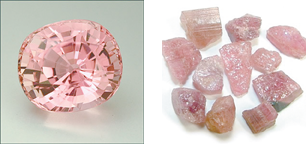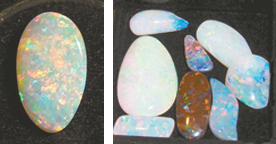October 2, 2009
Birthstones for October
Information provided by “Jewels For Me” at www.JewelsForMe.com
Check them out and read the rest of the story.
Tourmaline is the alternate birthstone for October, along with the opal. The stone was first discovered by Dutch traders off the West Coast of Italy in the late 1600’s or early 1700’s. The name tourmaline comes from the Sinhalese term “turmali,” which was the name given to all colored crystals on the island of Sri Lanka at that time. This all inclusive name indicates the inability of ancient gem dealers to differentiate tourmaline from other stones. In fact, at one time in history, pink and red tourmaline were thought to be rubies. Pink tourmaline tends to be pinker in color than ruby. However, their similarities in appearance are so strong that the stones in the Russian crown jewels believed to be rubies for centuries, are now thought to be tourmalines.

Pink tourmaline tends to be pinker in color than ruby.
The Chinese have engraved and carved figures with tourmaline for many centuries, and ancient examples are still displayed in museums, a testament to the durability of the stone. You may recall seeing intricately carved Chinese snuff bottles made from pink tourmaline.
For centuries, various cultures have had different beliefs about what virtues the tourmaline can bring to the wearer. In 18th Century literature, Barbara Walker cites references, which considered this stone to be helpful to artists, authors, actors and those in creative fields. In the same century, a Dutch scientist claimed that a tourmaline wrapped in silk and placed against the cheek of a feverish child would induce sleep. In Africa, tourmaline was once used as a stone to awaken one from “the dream of illusion.” Ancient ceremonies in India included the use of the gem as a tool to bring insight and help in the discovery of that which is good. It would also serve to make known who or what was the cause of troubles or evil deeds. The gem was also highly valued by alchemists who, perhaps because of it’s pyroelectric effect, believed it to be related to the philosopher’s stone. This was said to be the substance that would grant enlightenment, give power over spiritual affairs, reconcile opposites and change base metals to gold. In modern times, the stone is used by tribes in Africa, Native Americans, and aboriginal groups in Australia as a
talisman that protects against all dangers.

The Romans called the opal “the queen of gems” because it embodied the colors of all the other gems
Opal is the birthstone for the month of October, along with pink tourmaline. It is also the stone given to celebrate the 14th year of marriage. The name opal is thought to be derived from the Sanskrit upala, meaning “precious stone,” and later the Greek derivative “Opallios,” meaning “to see a change of color.”
The ancient Greeks used to prize opals as much as they did diamonds. The opals used in ancient times came from the former Czechoslovakia. The Romans also prized opals greatly and used them widely for jewelry. They called the opal “the queen of gems” because it embodied the colors of all the other gems. They revered opal as a symbol of hope and purity and regarded it as second only to the prized emerald. In the 1st century, Roman scholar and naturalist Pliny The Elder (AD23-79) wrote that opal “has an unbelievable mixture of colors.” He praised it as the ultimate in gemstones, due to its mysterious and iridescent qualities. Opals were used for jewelry and were also carved as cameos.
Opal has been a treasured gemstone around the world. The Aztecs have long mined opal in Central and South America. The Romans called Opal “Cupid Paederos”, a child as beautiful as love”, and wore it a symbol of hope, purity, and love, believing it had power to cure one from disease. Opal in the Middle Ages was used to treat diseases of the eye, and in later times, blond women used to wear opal earrings and hair ornaments, believing it would keep their hair from going gray.
The crown of the Holy Roman Emperor contained a striking Opal, called “Orphanus”. Described “as though pure white snow flashed and sparkled with the color of bright ruddy wine, and was overcome by this radiance”, this opal was said to guard the imperial honor. Opal was also found in the crown jewels of France. A legend tells a story of how Napoleon gave Josephine a brilliant Opal with red sparkles that he called “the burning of Troy”, asking her to become his Helen.
Shakespeare used an Opal in one of his plays to draw a parallel between Opal’s changing colors and the ever-changing moods of a woman. In “Twelfth Night” he wrote: “Now the melancholy God protect thee, and the tailor make thy garments of changeable taffeta, for thy mind is opal.”
No monarch has loved Opal more then Queen Victoria of England. She and her daughters created a trend for wearing Opal, and she was said to frequently give Opals as wedding presents, as a symbol of hope, happiness, and truth. Today, it is traditionally given on the 12th and 18th anniversaries of marriage.
Filed Under: History
Tags: 18th Century Literature, Ancient Ceremonies, Barbara Walker, Birthstone For October, Birthstones, Caus, Cheek, Chinese Snuff Bottles, Colored Crystals, Creative Fields, Durability, Dutch Scientist, Dutch Traders, Gem Dealers, Opal, Pink Tourmaline, Rest Of The Story, Rubies, Russian Crown Jewels, Time In History, Virtues
Trackback URL: https://www.50pluslife.com/2009/10/02/birthstones-for-october/trackback/


